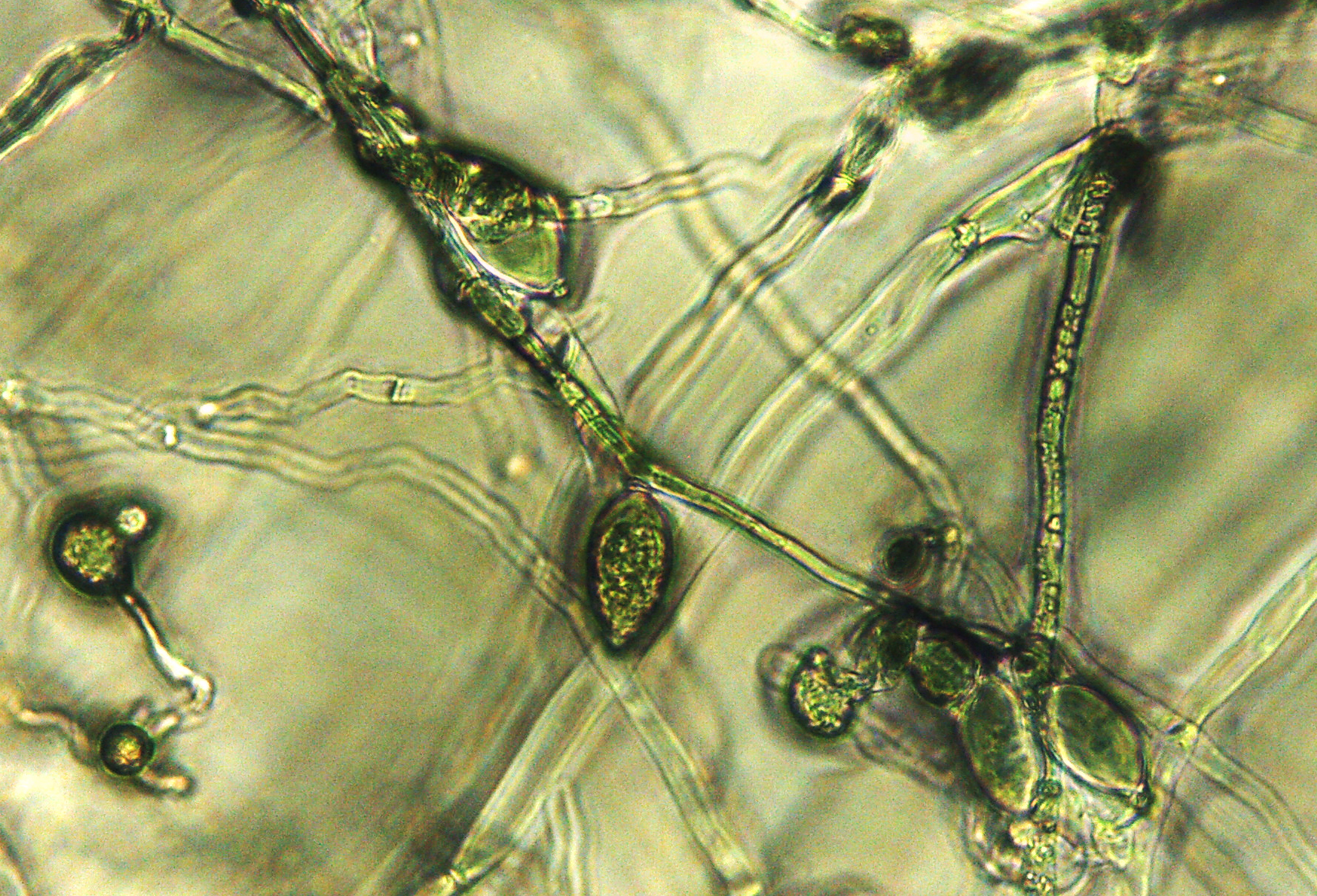Solanum tuberosum isolate sensitivity to Phytophthora infestans when using three systemic fungicides

Abstract
Phytophthora infestans is the causative agent of one of the most limiting diseases in potato crops (Solanum tuberosum) in the Department of Nariño, causing farmers to intensively use different fungicides, which reach 30% of production costs and are a serious environmental and public health problem. The purpose of this research was to support integrated disease management programs based on the generation of a baseline sensitivity of 20 P. infestans isolates from the Department of Nariño to three commercial fungicides composed of Metalaxyl 8% + Mancozeb 64% , Cimoxanil 6% + Propineb 70% and Fluopicolide 6% + Propineb 66.7%. This study was carried out using the in vitro methodology and five doses on an exponential scale. The results showed a heterogeneous behavior where some isolates showed resistance to the fungicide composed of Metalaxil + Mancozeb, reaching average EC50 values of 6.67 μg mL-1; while for the fungicides composed of Cimoxanil + Propineb and Fluopicolide + Propineb, there were intermediate and sensitive sensitivity levels with average EC50 values of 1.57 μg mL-1 and 2.61 μg mL-1. On the other hand, the sporulation rate was reduced in its entirety with the three fungicides for the evaluated doses of 100; 1,000; 10,000 μg mL-1.
Keywords
Resistance to fungicides, Peronosporal, Cymoxanil, Fluopicolide, Metalaxil, Potato
References
Briggs, G., D. Mansfield, B. Moloney, S. Gary y T. Wegmann. 2006. The discovery and chemistry of fluopicolide. A new estándar for Oomycetes disease control. Pflanzenschutz Nachr. 59, 141-152.
DANE, Departamento Administrativo Nacional de Estadística de Colombia. 2018. Encuesta Nacional Agropecuaria (ENA). Bogotá.
Escudero, M. 2005. Secuencia parcial del gen citocromo b de Phytophthora infestans y su relación con la resistencia al fenamidone. Trabajo de grado. Facultad de Ciencias Agropecuarias, Universidad Nacional de Colombia, Medellín, Colombia.
Erwin, D.C. y O.K. Ribeiro. 1996. Phytophthora diseases worldwide. APS Press, St. Paul, MN.
FRAC, Fungicide Resistance Action Committe. 2018. FRAC code list: fungicides stored by mode of action. Bruselas, Bélgica.
García, H., M. Marín, S. Jaramillo y J.M. Cotes. 2008. Sensibilidad de aislamientos colombianos de Phytophthora infestans a cuatro fungicidas sistémicos. Agron. Colomb. 26(1), 47-57.
Granada, N., C. Naranjo, J. Castaño y R. Castro. 2002. Efecto de once extractos vegetales sobre el tizón tardío causado por Phytophthora infestans (Mont) De Bary en papa (Solanum phureja). Agronomía 10(1-2), 2-20.
Grunwald, N.J., A.K. Stturbaum, G. Romero, E. Garay, H. Loyoza y W.E. Fry. 2006. Selection for fungicide resistance within a growing season in field populations of Phytophthora infestans at center of origin. Phytopathology 96, 1397-1403. Doi: 10.1094/PHYTO-96-1397
Gullino, M.I., E. Mescalchin y M. Mezzalama. 1997. Sensitivity to cymoxanil in populations of Plasmopara viticola in northern Italy. Plant Pathol. 46, 726-736. Doi: 10.1046/j.1365-3059.1997.d01-68.x
Jaramillo, S. 2004. Monografía sobre Phytophthora infestans (Mont) de Bary. Universidad Nacional de Colombia, Medellín, Colombia.
Keinath, A.P. y C.S. Kousik. 2011. Sensitivity of isolates of Phytohthora capsici from the Eastern United States to Fluopicolide. Plant Dis. 95(11), 1414-1419. Doi: 10.1094/PDIS-03-11-0242
Lagos, L.E. 2002. Aislamiento y caracterización genética de las poblaciones de Phytophthora infestans en las zonas productoras de papa Solanum tuberosum en el departamento de Nariño. Tesis de maestría. Facultad de Ciencias, Universidad del Valle, Cali, Colombia.
Marín, M. y J. Mira. 1998. Caracterización de razas fisiológicas y tipo de apareamiento en aislamientos de Phytophthora infestans (Mont.) De Bary, en diferentes pisos térmicos y hospedantes en el departamento de Antioquia. Trabajo de grado. Facultad de Ciencias Agropecuarias, Universidad Nacional de Colombia, Medellín, Colombia.
Montes, G., H. Lozoya, G. Mora, S. Fernández y N. Grünwald. 2012. Rendimiento de papa en función de epidemia por tizón tardío (Phytophthora infestans Mont. de Bary). Rev. Fitotec. Mex. 35(1), 69-78.
Nuninger, C., C. Steden, y T. Staub. 1995. The contribution of Metalaxyl-based fungicide mixtures to potato late blight control Phytophthora infestans 150. pp. 122-129. En: Dowley, L.J., E. Bannon, L.R. Cooke, T. Keane y E. O’Sullivan (eds.). European Association for Potato Research-Pathology Section Conference. Boole Press, Dublin, Irlanda.
Ochoa, D. 2004. Determinación de la sensibilidad en los aislamientos colombianos de Phytophthora infestans hacia Cymoxanil, Dimetomorf y Clorotalonil. Trabajo de grado. Facultad de Ciencias, Pontificia Universidad Javeriana, Bogotá.
Pérez, W. y G. Forbes. 2008. Manual técnico del tizón tardío de la papa. Centro Internacional de la Papa, Lima.
Santana, F.M., C.B. Gómez, C. Rombaldi, V.J. Bianchi y A. Reis. 2013. Characterization of Phytophthora infestans populations of souther Brazil in 2004 and 2005. Phytoparasitica 41, 557-568. Doi: 10.1007/s12600-013-0316-y
Saville, A., K. Graham, N.J. Grunwald, K. Myers, W.E. Fry y J.B. Ristaino. 2015. Fungicide sensitivity of U.S. genotypes of Phytophthora infestans to six oomycete-targeted compounds. Plant Dis. 99(5), 659-666. Doi: 10.1094/PDIS-05-14-0452-RE
Toquin, V., F. Barja, C. Sirven y R. Beffa. 2008. Fluopicolide, a new Anti-oomycetes fungicide with a new mode of action inducin perturbation of a spectrin-like protein. pp. 675-681. En: Kramer, W. y U. Schirmer (eds.). Modern crop protection compounds. Wiley-VCH Verlag, Weinheim, Alemania. Doi: 10.1002/9783527619580.ch19
Wang, W.Q., Z.Q. Ma, X.F. Zhang, W.J. Zhang y M. David. 2002. Resistance to fungicides, mating types and fitness of Phytophthora infestans. Acta Phytopathol. Sin. 32(3), 278-283.
